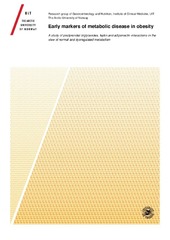| dc.contributor.author | Joseph, Josepha | |
| dc.contributor.author | Svartberg, Johan | |
| dc.contributor.author | Njølstad, Inger | |
| dc.contributor.author | Schirmer, Henrik | |
| dc.date.accessioned | 2011-09-23T08:02:09Z | |
| dc.date.available | 2011-09-23T08:02:09Z | |
| dc.date.issued | 2010 | |
| dc.description.abstract | Many incident cases of type 2 diabetes do not
fulfill the metabolic syndrome, which accordingly has been questioned both as a research and clinical tool. The aim of this study was to determine differences in risk factors for type 2 diabetes between groups with high or low metabolic
score. The study population were 26,093 men and women attending the Tromsø Study in 1994, followed through 2005, and who did not have diabetes when entering the study. A total of 492 incident cases of type 2 diabetes were registered. A metabolic score was defined according to a modified version of the National Cholesterol Education Program Adult Treatment Panel III. For those fulfilling C 3 metabolic score criteria, increasing age, body mass index (BMI), triglycerides and a family history of diabetes were independent predictors. Age, BMI, and triglycerides predicted type 2 diabetes more strongly in subjects with low metabolic score, whereas high HDL cholesterol was not protective in this low risk group. The risk associated with a positive family history was unaffected by level of metabolic score. In addition smoking, low education and in men also physical inactivity were independent risk factors only in those with low metabolic score. Adding these nonmetabolic
risk factors increased correct classification from
an ROC area of 77.2 to 87.1% (P value\0.0001). One
half of the incident cases of type 2 diabetes were missed by using high metabolic score for risk prediction | en |
| dc.description | This article is part of Josepha Joseph's doctoral thesis, which is available in Munin at <a href=http://hdl.handle.net/10037/2968>http://hdl.handle.net/10037/2968</a> | en |
| dc.identifier.citation | European journal of epidemiology, vol. 26, number 2, 117-124 | en |
| dc.identifier.doi | doi: 10.1007/s10654-010-9540-7 | |
| dc.identifier.uri | https://hdl.handle.net/10037/3626 | |
| dc.identifier.urn | URN:NBN:no-uit_munin_3342 | |
| dc.language.iso | eng | en |
| dc.publisher | Springer | en |
| dc.rights.accessRights | openAccess | |
| dc.subject | metabolic syndrome | en |
| dc.subject | low metabolic score | en |
| dc.subject | high metabolic score | en |
| dc.subject | non-metabolic risk factors | en |
| dc.subject | receiver operating characteristics | en |
| dc.subject | type 2 diabetes | en |
| dc.subject | VDP::Medical disciplines: 700::Clinical medical disciplines: 750::Endocrinology: 774 | en |
| dc.subject | VDP::Medisinske Fag: 700::Klinisk medisinske fag: 750::Endokrinologi: 774 | en |
| dc.subject | VDP::Medical disciplines: 700::Health sciences: 800::Preventive medicine: 804 | en |
| dc.subject | VDP::Medisinske Fag: 700::Helsefag: 800::Forebyggende medisin: 804 | en |
| dc.subject | VDP::Medical disciplines: 700::Health sciences: 800::Epidemiology medical and dental statistics: 803 | en |
| dc.subject | VDP::Medisinske Fag: 700::Helsefag: 800::Epidemiologi medisinsk og odontologisk statistikk: 803 | en |
| dc.title | Risk factors for type 2 diabetes in groups stratified according to metabolic syndrome : a 10-year follow-up of The Tromsø Study | en |
| dc.type | Journal article | en |
| dc.type | Tidsskriftartikkel | en |
| dc.type | Peer reviewed | en |


 English
English norsk
norsk


